
Before we dive into the reasons and causes of the rejection of fingerprints by the Royal Canadian Mounted Police (RCMP), let’s first understand the process of how the digital fingerprints, transmitted to the RCMP for obtaining a certified criminal record check, are compared to the fingerprints already stored in the national repositories database to find out the possible “match” or “no match”.
The fingerprints comparison process is not as simple, as it may seem to be. If you look at your own fingers or fingerprints, you will notice that they have specific patterns like loops, whorls, arches, double loops, etc. You may think that these pattern types are used for the comparison process and they are the sole basis to determine if the fingerprints match or do not match.
The fingerprint patterns are common in millions of people and they are not the only basis for the comparison of two or more fingerprints.
Although with the development of the Automated Fingerprint Identification System (AFIS) it has become easier and faster to compare an unknown fingerprint with the millions of known fingerprints in a matter of minutes, however, this comparison is only possible if the unknown fingerprint(s) are clear enough for the comparison process.
The term “clear enough” means a fingerprint has a sufficient available set of minutiae data (distinguishing features, ridge characteristics), which can be compared to the other fingerprints to find out if there is a match or no match.
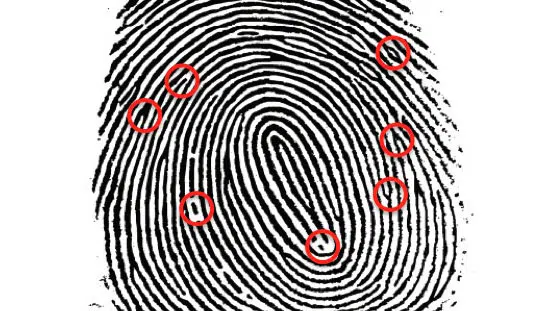
The above photomicrograph shows ridges (in black) and
furrows (in white). Minutiae or ridge characteristics
are the deviations (bifurcations, ridge-endings, eye-lets,
short ridges, ridge dots, etc.) from the normal ridges
(shown with red circles). These minutiae are in fact
compared to find out if two fingerprints match
or do not match.
So if a fingerprint does not have clear minutiae, it cannot be compared to the other fingerprints to find out if there is a match or no match.
Now we understand the main cause of the rejection of fingerprints by the AFIS system. Let’s move on to the illustrations of good fingerprints and bad fingerprints.
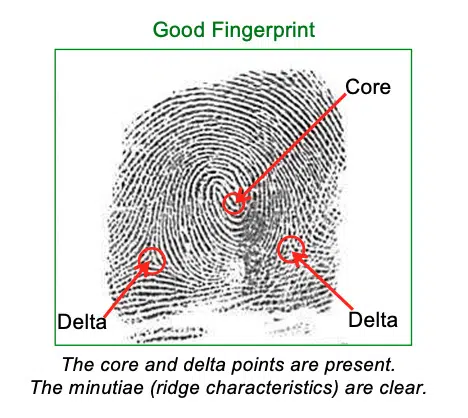
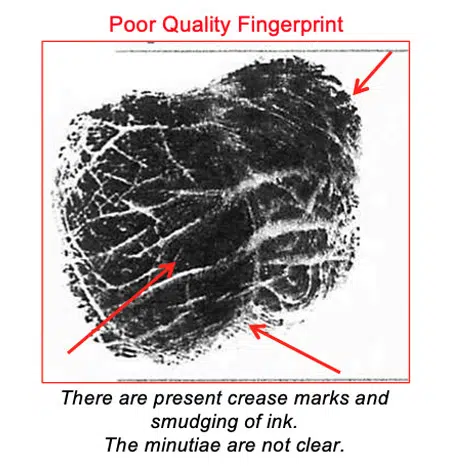
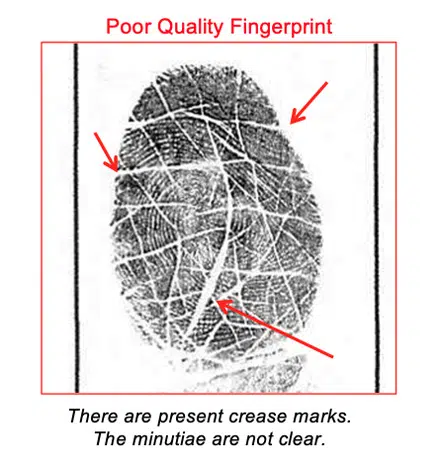
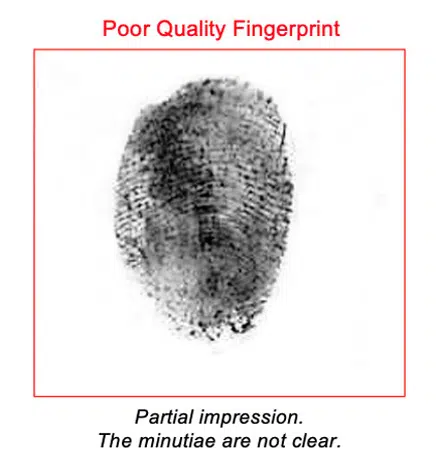
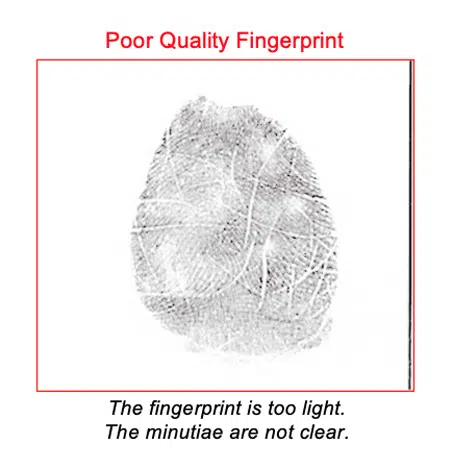
Common causes of low-quality fingerprints
There can be many physical or technical reasons for the cause of unclear fingerprints. They include:
- Hands dry or too sweaty.
- Skin conditions: crease marks, scars, cuts, and dry skin.
- Too much ink is applied on the fingers (fingerprints show smudging of ink).
- Not enough ink covers the entire fingertip (fingerprints are too light).
- Use of poor-quality ink.
- Uneven pressure was applied during the taking of fingerprints.
- For rolled impressions, the finger is not rolled properly from nail to nail.
- Fingerprint ridges are worn due to age, type of work, and exposure to chemicals such as bleach, chlorine, acetone, or medical conditions.
- Physical limitations.
- The fingerprinting agent only took partial prints.
- Amputated or Missing fingers.
Possible Solutions
If you have worn ridges, dry hands, or wrinkles (crease marks), moisturize your hands for 8-10 days before getting fingerprints taken. The use of O’Keeffe’s Working Hands cream also helps a lot to improve the skin conditions of the fingers.
If your hands are sweaty, wipe them frequently while being fingerprinted. You can even cool your hands with cold water and dry them before being fingerprinted.
If your fingerprints show dark smudging of ink, reduce the pressure and ask the technician to use proper fingerprinting ink. The stamp pads or poor-quality inks often cause smudging of ink.
If your fingerprints are too light and do not show clear ridges, try to use a better quality darker fingerprinting ink. Cheap-quality inks or partially dried inks often result in low-quality fingerprints.
In case the fingerprints have worn out due to old age, better get them taken with a live-scan device. The live-scan equipment produces better images and it is possible to retake fingerprints to get the best results.
If you are in a profession where the use of hand sanitizers, frequent washing of hands, or handling chemicals seem to have affected the skin condition of your hands, take a break before your fingerprinting appointment.
The best option will be to get fingerprints taken by a properly trained professional with a live-scan device and get them printed on a standard fingerprint form. At the time of taking fingerprints, if you feel that the technician is not properly trained to take fingerprints, try to find another location to avoid the possible hassle of getting them rejected and going through the whole process again.
Why Choose Worldwide Forensic Services Inc.
Contact Worldwide Forensic Services Inc.